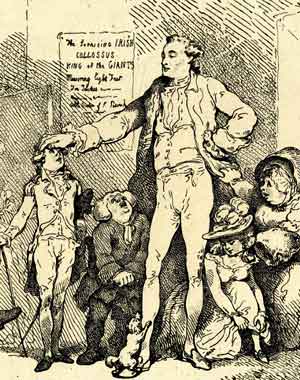BITE-SIZED HISTORY
Published in Issue 2 (March/April 2023), Volume 31‘A WALL FOR ALL’
At the annual Bloody Sunday Festival in Derry, a braille translation has been added to the Free Derry Wall. The signage was unveiled by Children in Crossfire founder Richard Moore, who was blinded by a rubber bullet at the age of ten in 1972. To Moore, the sign is about ‘raising awareness around issues relating to disabled people … There are many, many people out there with disabilities who suffer and struggle every day of their lives and they will get inspiration from this.’ The story of the iconic gable wall is well told in the neighbouring Museum of Free Derry (www.museumoffreederry.org).
THE IRISH GIANT
Charles Byrne (1761–83) was regarded as something of a curiosity in Georgian London, drawing crowds eager to see him in the flesh. Though his exact height is disputed, Byrne was known as ‘the Irish Giant’, standing at a height of at least 7ft 7in. Fearful of what might happen to his mortal remains after his death, Byrne insisted on being buried at sea. Readers of one newspaper were told of how his coffin had been ‘thrown into the sea, agreeable to his own request, he having been apprehensive that the surgeons would anatomize him’. But what was in the coffin? Not Byrne, whose remains went on display in the Hunterian Museum at the Royal College of Surgeons in Lincoln’s Inn Fields, London. The museum has now announced that Byrne’s skeletal remains will no longer be displayed, in recognition of ‘the sensitivities and the differing views surrounding the display and retention of Charles Byrne’s skeleton’.
THE LEAGUE OF IRELAND
History conferences generally happen in university settings, but in January 2022 leading figures from the field of sports history in Ireland gathered under the hallowed Jodi Stand in Dalymount Park for a one-day event exploring the history of association football in Ireland. This marked the publication of The League of Ireland: an historical and contemporary assessment (Routledge Press), edited by Conor Curran. Chapters explore themes like Irish Civil War attitudes to sport, the Belfast–Dublin split in soccer administration and Peter Peel, the Dublin-born president of the United States Football Association. Curran is also the author of a forthcoming history of soccer in Dublin from Four Courts Press.
FAIRVIEW PARK
Congratulations to the team behind the pending Irish short film release Fairview Park, who successfully crowd-sourced funding via website Greenlit. Written by Eillie Hodgetts, Fairview Park tells the story of the murder of Declan Flynn in 1982, a moment which sparked fury and protest in the city. All five ‘queer-bashers’ convicted of Flynn’s killing walked away from court with suspended sentences, leading David Norris to comment that ‘it could be interpreted as a licence to kill’. Flynn’s murder led to a demonstration of several hundred people marching from Liberty Hall to Fairview Park, to that point the largest gay rights demonstration witnessed in Ireland. A brief teaser of the film is available to view now at www.greenlit.com/project/fairview-park.
REMEMBERING LIAM Ó BUACHALLA
A new plaque has been unveiled in Drogheda honouring Liam Ó Buachalla, a defining figure in the Irish-language movement in the early decades of the state. Born in Dublin’s Clanbrassil Street in 1899, Ó Buachalla moved to Drogheda at a young age and joined the republican movement during the War of Independence. President of Conradh na Gaeilge in the 1940s, Ó Buachalla produced a number of important Irish-language textbooks and was also instrumental in campaigning for the statue of Pádraig Ó Conaire in Galway’s Eyre Square. The impressive new plaque to Ó Buachalla, which is naturally bilingual and which includes a fine artistic representation of Ó Buachalla himself, is affixed to the Scholars’ Townhouse Hotel.
DOORS INTO DOCKLANDS
Augmented reality (ask any young relative who has played Pokemon Go) is very much in fashion in the world of mobile phone applications. Congratulations to all at Dublin Discovery Trails, an initiative of Dublin City Council and Fáilte Ireland, who have launched the new Doors into Docklands discovery trail. Easily downloaded onto any smart mobile phone, this application encourages visitors to walk through Dublin’s docklands and brings history to life using augmented reality software. We can see the Custom House burn as it did in 1921, or step into the CHQ building and see the massive banquet held there for soldiers returning from the Crimean War. Actors bring to life characters from the area, ranging from the Dublin dockers who worked there in their thousands before containerisation to the revolutionary Elizabeth O’Farrell. Lesser-known features include the Liffey Ferry, which has returned to service in recent times, and the innovative diving-bell developed by engineer Bindon Blood Stoney, which allowed the construction of the contemporary Liffey walls. Of course, nothing will ever replace the charm of a good walking-tour guide, but isn’t it nice to see how technology can bring the past to life? Available at www.doorsintodocklands.com.

















